With the development of industrial automation, smart manufacturing and the Internet of Things, the market demand for motion control solutions continues to grow. As a key technology to drive mechanical motion, motors and motion control systems are widely used in industrial automation, robotics, consumer electronics, medical equipment, autonomous driving and smart home industries. According to market research firm GMI, the global motion control market will be worth about $20.3 billion in 2023. The market is expected to grow at a compound annual growth rate (CAGR) of 5.5% during the period from 2024 to 2032, and the market size is expected to reach $33.4 billion in 2032.
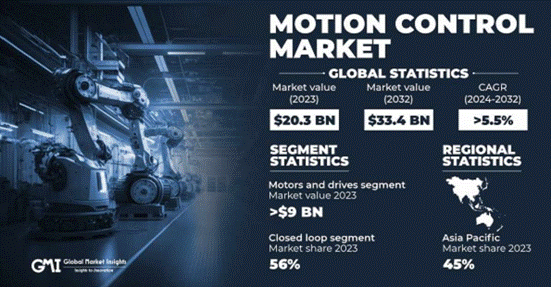
Motors and motion control are the core areas of modern industrial and technological applications. ADI has industry-leading motor and motion control products designed to perfectly translate digital information into physical motion, enabling Industry 4.0 to play a role in advanced robotics, automation, medical prosthetics, 3D printing and more. From the underlying chip to the upper module, ADI offers a full range of solutions with a broad portfolio of motors, encoders, motor control ics and modules that increase the efficiency of intelligent motion systems, reduce physical size, and reduce time to market.
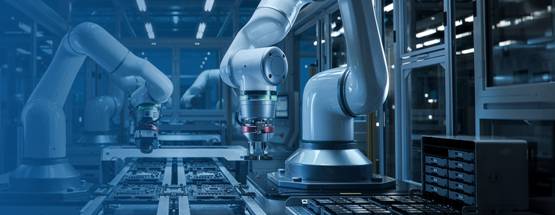
Step Motor (Step Motor)
Stepper motor is a kind of motor that can convert electrical pulse signal into precise angular displacement, usually consisting of two parts: stator and rotor. There are windings on the stator and teeth on the rotor. By controlling the electrification sequence of the stator windings, the motor can rotate gradually at a fixed step Angle. By converting electrical energy into mechanical energy, stepper motors can control motion in a precise and predictable way, so they are widely used in situations where precise positioning and speed control are required.
According to the structure and working principle, stepper motors can be divided into many types, including: permanent magnet stepper motor (PM), variable reluctance stepper motor (VR) and hybrid stepper motor (HB). Each type has its own unique characteristics and application scenarios. According to the different driving methods, it can also be divided into bipolar and unipolar stepper motors. Choosing the right type of stepper motor depends on the specific application needs, including factors such as accuracy, torque, speed and cost.
Stepper motors work by sending an electric current through the coils of the motor, creating an electromagnetic field that forces the magnetic rotor into the desired position. This can be done in full step, half step, or smaller micro-steps using additional current states. Microstepper improves the accuracy, torque, energy efficiency and smoothness of stepper motor applications while reducing stepper losses, vibration and noise.
Stepper motor drivers can achieve extremely precise and smooth motion by subdividing the whole step into smaller microsteps for control using sinusoidal current waveforms. ADI Trinamic™ technology subdivides each full step into up to 256 micro-steps, transforming digital information into smooth physical movements. The resulting current control scheme reduces noise and vibration while increasing achievable torque and accuracy.
The stepper motor is a durable open-loop motor, which is the only type of motor that can accurately control the position and accurately achieve the speed under the open-loop condition. It offers many advantages over other motors, such as high torque at low speeds and at rest, no accumulation of marginal positioning errors, excellent start/stop response, cost effective and easy to use. When accurate and reliable open-loop positioning is required, stepper motors are the preferred choice.
For ADI's stepper motor driver products, WT Winye Technology, the world's leading authorized agent of electronic components, combined with the current market, focuses on recommending a silent stepper motor driver TMC5240, which is superior in efficiency and space to market products of the same class.
The TMC5240 is an intelligent high-performance stepper motor controller and driver IC with serial communication interfaces (SPI, UART) and extensive diagnostic capabilities. It combines a flexible, acceleration-optimized ramp generator (for automatic target positioning) with the industry's most advanced stepper motor driver (based on a 256-step built-in indexer and two fully integrated 36V, 3.0A (Max) H-bridges and non-dissipative integrated current sensing (ICS).
The controller is about twice as efficient as other solutions on the market today, is highly integrated in terms of space (saving 60%+), and has excellent current and motion control. ADI's advanced StealthChop2 chopper ensures the industry's lowest noise levels and ensures efficiency and torque. High integration, energy efficiency and small size enable systems to be miniaturized and scalable for cost-effective solutions. The complete solution significantly reduces the learning curve for application developers while providing superior performance over competitors.
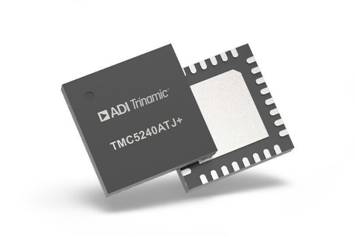
Servo motor (BLDC/PMSM/DC Servo Controller)
Servo motor is a kind of motor that can accurately control Angle, speed and position, and is widely used in fields requiring high-precision motion control. The Servo motor works with the Servo Controller to form a closed-loop control system, through which the command signal is received and converted into the movement of the motor shaft to achieve accurate positioning and speed control.
Servo motor controller to control the servo motor, the system is widely used in areas requiring precise position, speed and torque control, such as industrial automation, robotics, CNC machine tools, medical equipment and automated production lines. Different from the stepper motor controller, the core function of the servo controller is to achieve Closed-loop Control. The servo controller introduced in this paper mainly includes brushless DC motor (BLDC), permanent magnet synchronous motor (PMSM) and DC motor servo controller.
Firstly, the brushless DC motor servo controller realizes the precise control of BLDC motor through electronic commutation technology and closed-loop control system, which is widely used in application scenarios requiring high precision, high efficiency and high response speed, such as industrial automation, robotics and precision instruments. The core of the PMSM/DC servo controller is also to achieve closed-loop control of the motor to achieve precise control of position, speed and torque, so it is also used in this scenario.
Based on the market performance, Wen highlighted the industry's fully integrated servo controller TMC4671, which provides field-oriented control (FOC) for BLDC/PMSM, 2-phase stepper motors, and DC motors and voice coils. All control functions are implemented in hardware, and the integrated ADC, position sensor interface, and position interpolator make the fully functional servo controller suitable for a variety of servo applications, such as robotics, pickers, factory automation, electric vehicles, and more.
The ADI TMC4671 is a powerful chip dedicated to motion controllers that maximizes drive efficiency and dynamic performance, and with all the time-critical calculations in the hardware, the development of dynamic servo controllers requires only a few lines of code, thus rapidly reducing time to market for high-performance servo controllers.
The TMC4671 has a switching frequency and controller update rate of up to 100kHz, and features filtering and interpolation features such as digital Hall signal interpolation for smoother operation. The integrated circuit can work with A wide range of encoders, from A/B/Z incremental simple digital or analog Hall sensors to high-resolution sine/cosine analog encoders. Sensors can be flexibly mapped as inputs to position and speed control loops.
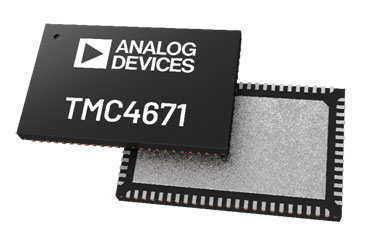
DC Motor (DC Motor)
A Brushed DC Motor is a motor that drives the rotor of the motor by reversing the current through a mechanical commutator and a brush, consisting of a stator (usually a permanent magnet) and a rotor (a coil winding). It is one of the common motor types, with simple structure, low cost and easy control characteristics, widely used in all kinds of small power tools, household appliances, toys and automobiles.
The DC brushed motor driver is responsible for providing the current and voltage required by the DC brushed motor to control the speed and direction of the motor, although the system faces the competitive pressure of brushless motor systems, the simple control method, low cost and a wide range of applications still make it an important position in the market. Future developments will focus on improving energy efficiency, intelligence, miniaturization, improving EMI/EMC performance, and meeting specific market needs.
In this regard, Wen Ye recommended ADI's ultra-small size single-channel brush motor driver solution MAX22201/2/7 based on the current market. The chip integrates a 36V, 3.5A peak full bridge to drive a brushed DC motor. The full bridge has a very low impedance FETs, typical RON (high side + low side) of 0.3Ω, enabling high drive efficiency. The rated peak current of 3.5A is limited by the Current Protection threshold (OCP). Peak current is defined as the maximum current that a driver can provide in response to short transients.
It is worth mentioning that the maximum effective current (RMS) of this driver is 2A, which is usually limited by thermal considerations. The 2ARMS current value refers to the value obtained by the standard JEDEC 4-layer plate at an ambient temperature of 25°C. The actual maximum operating current depends on the thermal characteristics of the application (PCB ground plane, heat sink, ventilation, etc.).
The MAX22201/2/7 features an accurate lossless integrated current detection (ICS) function and an embedded internal current drive regulation (CDR) circuit to monitor current passing through the motor coil and limit peak output current. When the motor current exceeds the current limiting threshold, the full bridge enters attenuation mode and continues with a fixed turn-off time (tOFF).
For brush motor drive applications, current drive regulation ensures safe and reliable operation of the drive under normal conditions or under motor start and stall conditions, while reducing system power and power bypass requirements. A scaled copy of the internal sensing current is output to the external pin (ISEN). All versions feature overcurrent protection (OCP), thermal shutdown (TSD), and undervoltage protection (UVLO). Each time a FAULT condition is detected, an open leak low-level active fault indicator pin (FAULT) is activated.
The device is available in a small TDFN12 3mm x 3mm package. With its small size package, high efficiency and integrated accurate current detection, the MAX22201/2/7 is ideal for space - and power-sensitive applications such as brushed DC motor drives, locking and solenoid valves, and single-phase stepper motor drives.
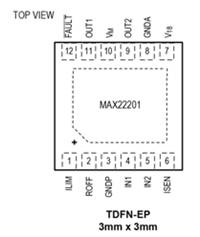
H-Bridge Driver (H-Bridge Driver)
An H-Bridge Driver is a circuit configuration that controls the direction and speed of a DC motor. It utilizes four switches (usually transistors or MOSFETs) connected in a "bridge" that allows current to flow through the motor in both directions. H-bridge drives are widely used in robotics, power tools, automotive power seats and industrial automation.
H-bridge drivers have many advantages, such as bidirectional control of the positive and negative rotation of the motor, suitable for applications that require frequent rotation direction changes; The motor speed can be precisely controlled by pulse width modulation (PWM) technology. The motor can be stopped quickly (short-circuit braking) by simultaneously conducting the diagonal switch; It also has the advantages of simple structure and low cost.
H-bridge driver is a flexible and efficient motor control solution, which can realize bidirectional control and speed adjustment of DC motor through reasonable selection and design, and improve the performance and reliability of the system. Based on the current market, WT WYE highlights the industry's ultra-small 65V, 3.8A dual brush or single channel stepper motor driver solution MAX22203 with integrated current detection.
The MAX22203 is a dual-channel 65V, 3.8AMAX H-bridge driver that provides PWM input and high-precision current drive regulation (CDR), an integrated CDR that can limit the start or stop of a brushed DC motor, or control the phase current for step-click operation. Each H-bridge can be individually controlled and has an ultra-low typical RON of 0.3Ω (high side + low side) for high drive efficiency and low heating. The MAX22203 can be used to drive two brushed DC motors or a single stepper motor.
The bridge output current is detected by the lossless integrated Current Detection (ICS) function, which eliminates the need for bulky external power resistors (often necessary for this function), and compared to a configurable threshold current (ITRIP). By connecting external resistors to pins REFA and REFB, ITRIP thresholds can be set independently for both full Bridges.
Each H-bridge has a maximum output current of IMAX = 3.8A and is limited by a current protection (OCP) circuit. This current can be driven for very short transients and is designed to drive small capacitive loads efficiently. The maximum current adjustment threshold that users can configure is ITRIP_MAX = 3A. On a standard JEDEC 4-ply board, the maximum RMS current (IRMS) per H-bridge is 2ARMS. The maximum RMS current may be limited by thermal considerations and depends on the thermal characteristics of the application (PCB grounding, heat sink, forced ventilation, etc.).
The MAX22203 features overcurrent protection (OCP), thermal shut-off (TSD), and undervoltage latching (UVLO). An open leak low-level active nFAULT pin is activated each time a fault condition is detected. During the hot shutdown and undervoltage lock, the drive is in three states until normal operation is restored. This period comes in a small TQFN38 5mm x 7mm package.
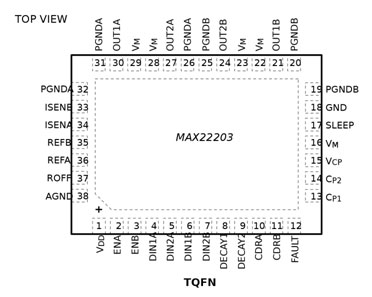
In summary, ADI motion control solutions meet the stringent requirements of industrial automation, intelligent manufacturing and the Internet of Things with their advanced technology and superior performance. Ensure noise-free operation and excellent motor torque control with the innovative StealthChop2 chopper technology and high-precision current control. The efficient dynamic response and precise current regulation of the TMC4671 servo controller and MAX22203 H-bridge driver make them outstanding in a variety of demanding applications.
免责声明: 本文章转自其它平台,并不代表本站观点及立场。若有侵权或异议,请联系我们删除。谢谢! Disclaimer: This article is reproduced from other platforms and does not represent the views or positions of this website. If there is any infringement or objection, please contact us to delete it. thank you! |


